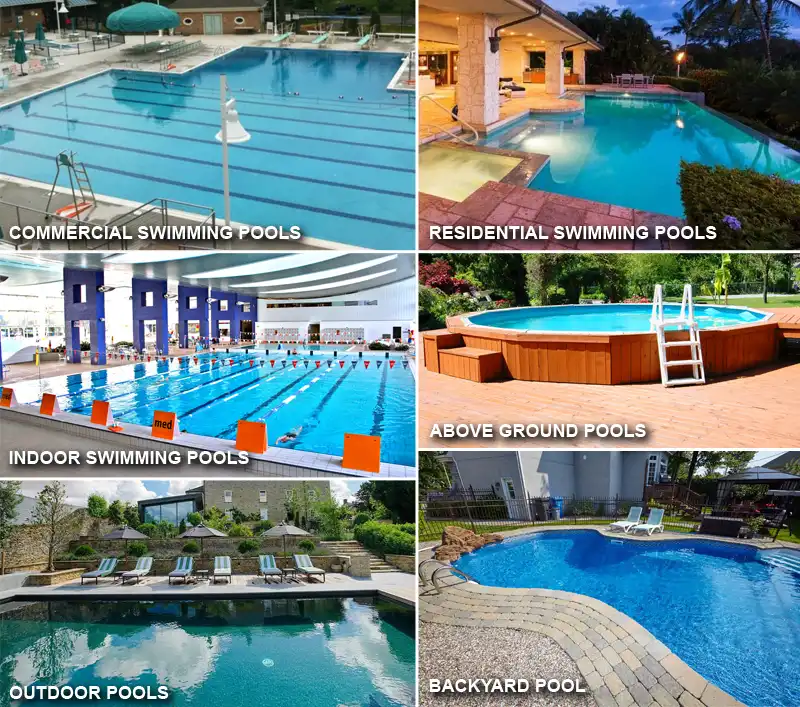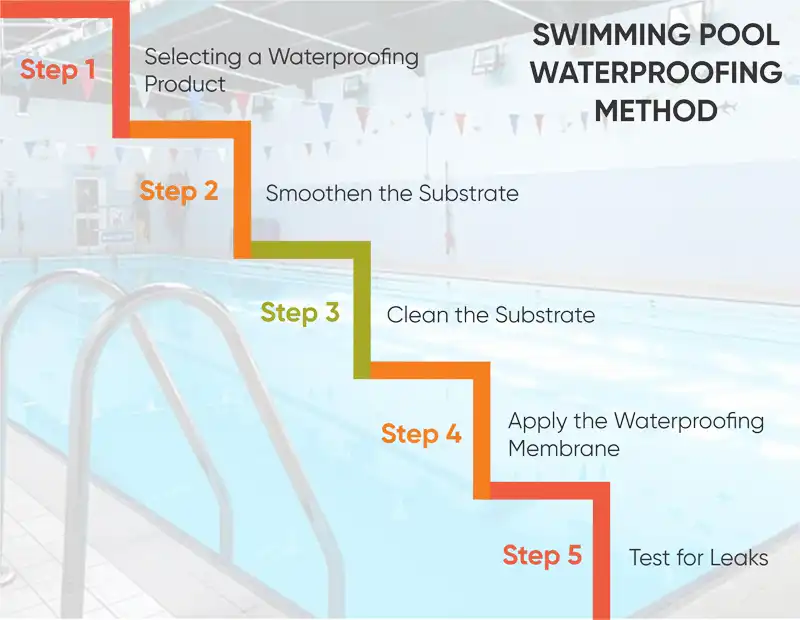Swimming pools come in all different types, designs, sizes, and shapes and are used for various purposes. To maintain a swimming pool it is essential to make sure that its structure is waterproofed to protect the surfaces and the walls from all the aggressive agents that can compromise its durability,
Water plays an important role in the swimming pool structure and is an aggressive factor both for its frame and for all materials used in its construction. Talking about the importance of the material being used. One must ensure to provide a secure and convenient entry n exit to the pool. To make sure you are covered here, check out heavy-duty pool steps these work wonders. The walls and the ground of a swimming pool are subjected to various penetrations such as inlets, skimmers throats, lighting fixtures, cleaning systems, and more. All this and the constant water pressure can lead to frustrating leaks. The concrete shells must be sealed to ensure they hold the water.
Once the purpose of the swimming pool has been fixed, that is refurbishment / new installation, it will be possible to define both the most suitable type of foundation and the most appropriate waterproofing system.
Different types of swimming pools
- Commercial Swimming Pools
- Residential Swimming Pools
- Above Ground Pools
- Indoor Swimming Pools
- Outdoor Pools
- Concrete Swimming Pools
- Fiberglass Pools
- Vinyl Liner Swimming Pools
- Soft Wall Swimming Pools
- Blow Up Pools
- Backyard Pool
- Infinity Pools
- 3d Swimming Pools

Why do we need swimming pool waterproofing?
The Swimming pool waterproofing is needed because they are more subjected to the constant pressure of water. The factors include;
- Shrinkage cracks that appear during the concrete curing process
- Lack of waterproofing barriers between the pool water and concrete wall
- Failures in plumbing and suction lines
- The formation of honeycombs during the concreting process, which weaken the structure
- Construction joints
- Pipe Penetrations
- Corrosion is caused by permeable water and air through the surfaces
Elements to consider when waterproofing swimming pools
Many issues can be prevented by a swimming pool contractors in Dubai during a planning phase of the construction or renovation of swimming pools. Different elements are important to be considered;
- Analysing the surrounding temperature and the functional requirement as demanded by the client
- The waterproofing membrane must be sealed properly to withstand the hydrostatic pressure of water
- The surface of the pool shall be provided with such a system, which provides durable, easy to clean, withstand chemicals affect and no color change,
- The painting or tiling layer should not be considered to be a waterproofing layer
- A proper under-tile waterproofing system should always be applied
- Waterproofing, corners shall be treated using water sealing tapes
- At the time of the installation of tiles, a minimum joint width of 2-3mm shall be maintained and shall be grouted with cement grout
- The waterproofing system used must comply with both positive and negative water pressure

Swimming pool waterproofing method
Step 1- Selecting a Waterproofing Product:
- The product must address both positive and negative hydrostatic pressure. Positive hydrostatic pressure comes from the substrate above and negative, water pressure comes from beneath the pool’s substrate.
- The right product must be applied to the substrate’s surface and allowed to cure before tiling begins.
- Select a membrane that allows for the direct bonding of tile for an efficient installation.
- The product selected depends on the water coverage of pool types[ kid and adult].
Step 2- Smoothen the Substrate
- You need to bring any variations in the pool’s wall or floor within acceptable water levels.
- The additive can be used effectively in this application for swimming pools.
Step 3- Clean the Substrate
- To facilitate a strong bond between your waterproofing membrane and the tile, ensure that the substrate is properly prepared.
- To start with, remove contaminants like grease, dust and residues along with loose materials from honeycombing or laitance are removed from the substrate with pressure washing, sandblasting, shot blasting and grinding.
- Next, all penetrations, joints, seams, corners, drains and expansion/control joints that can undermine the best waterproofing system are sealed.
- The surface must be cleaned with a wet sponge and left to dry before applying the membrane.
- After final preparation, remove all dust by vacuuming, clean the surface with a wet sponge and let it dry before applying the membrane.
Step 4- Apply the Waterproofing Membrane
- Once the swimming pool is ready for waterproofing, the entire surface is coated with the membrane as per the manufacturer’s specifications.
- It is crucial to check for restrictions on temperature ranges during the application, to facilitate a strong bond for the waterproofing membrane.
- A quality product is typically plastered in three layers. It can be applied by roller, trowel or spray over concrete as new as three days old and cures in just two to three hours.
- All flashing should be done per the product instructions using Waterproofing Mesh. Once flashing is complete, apply the membrane to the entire surface using a nap roller, v-notch trowel, or airless sprayer.
- Apply the first coat in a minimum of 2- 25 mils[ Wet FIlm Thickness]. Allow this coat to dry for 1 -2 hours, or until the membrane becomes semi-transparent. Then apply a second coat, at a right angle to the first coat.
Step 5- Test for Leaks
- Once the membrane is properly cured, test to make sure the pool is watertight before beginning the tile installation.
- After one week of curing, a flood test or phase test must be conducted to make sure the pool is watertight to begin the tile installation. However, if any leak is detected there is a glitch that needs to be rectified with repairs.
- If no leaks are detected, fill the pool above the first level of fixtures and repeat testing.
- If a leak is detected at any stage, drain the pool as much as necessary to conduct repairs.

Conclusion
The choice of waterproof coating is extremely important. Meanwhile, as a movement that directly contacts the human body movement, it requires the swimming pool not only to have the most high quality waterproof performance, but also requires the pool wet film with anti breeding bacteria, anti-ultraviolet, and anti-aging characteristics.


